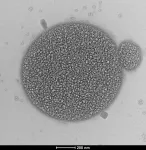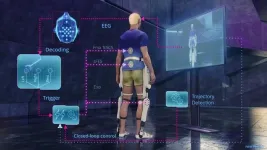(Press-News.org)
PULLMAN, Wash. – Bacteria can be tricked into sending death signals to stop the growth of their slimy, protective homes that lead to deadly infections, a new study demonstrates.
The discovery by Washington State University researchers could someday be harnessed as an alternative to antibiotics for treating difficult infections. Reporting in the journal, Biofilm, the researchers used the messengers, which they named death extracellular vesicles (D-EVs), to reduce growth of the bacterial communities by up to 99.99% in laboratory experiments.
“Adding the death extracellular vesicles to the bacterial environment, we are kind of cheating the bacteria cells,” said Mawra Gamal Saad, first author on the paper and a graduate student in WSU’s Gene and Linda Voiland School of Chemical Engineering and Bioengineering. “The cells don’t know which type of EVs they are, but they take them up because they are used to taking them from their environment, and with that, the physiological signals inside the cells change from growth to death.”
Bacterial resistance is a growing problem around the world. In the U.S., at least 2 million infections and 23,000 deaths are attributable to antibiotic-resistant bacteria each year, according to the U.S. Centers for Disease Control. When doctors use antibiotics to treat a bacterial infection, some of the bacteria can hide within their tough-to-penetrate, slimy home called a biofilm. These subpopulations of resistor cells can survive treatment and are able to grow and multiply, resulting in chronic infections.
“They are resistant because they have a very advanced and well-organized adaptive system,” said Saad. “Once there is a change in the environment, they can adapt their intracellular pathways very quickly and change it to resist the antibiotics.”
In their new study, the researchers discovered that the extracellular vesicles are key to managing the growth of the protective biofilm. The vesicles, tiny bubbles from 30 to 50 nanometers or about 2,000 times smaller than a strand of hair, shuttle molecules from cells, entering and then re-programming neighboring cells and acting as a cell-to-cell communications system.
As part of this study, the researchers extracted the vesicles from one type of bacteria that causes pneumonia and other serious infections. They determined that the bacteria initially secrete vesicles, called growth EVs, with instructions to grow its biofilm, and then later, depending on available nutrients, oxygen availability and other factors, send EVs with new instructions to stop growing the biofilm.
The researchers were able to harness the vesicles with the instructions to stop growth and use them to fool the bacteria to kill off the biofilm at all stages of its growth. Even when the biofilms were healthy and rapidly growing, they followed the new instructions from the death EVs and died. The death EVs can easily penetrate the biofilm because they are natural products secreted by the bacteria, and they have the same cell wall structure, so the cells don’t recognize them as a foreign enemy.
“By cheating the bacteria with these death EVs, we can control their behavior without giving them the chance to develop resistance,” said Saad. “The behavior of the biofilm just changed from growth to death.”
WSU Professor and corresponding author Wen-Ji Dong, who has been studying the vesicles for several years initially thought that all of the bacterial-secreted vesicles would promote cell growth. The researchers were surprised when they found that older biofilms provided instructions on shutting themselves down.
“So now we’re paying attention to the extracellular vesicles secreted by older biofilms because they have therapeutic potential,” he said.
The researchers are applying for research funding from the National Institutes of Health to continue investigating exactly how the messengers work and how well the process works with other bacterial types or fungi. They are working with WSU’s Office of Commercialization and have applied for a provisional patent.
END
Text-to-image generative AI systems like Midjourney, Stable Diffusion, and DALL-E can produce images based on text prompts that, had they been produced by humans, would plausibly be judged as “creative.” Some artists have argued that these programs are a threat to human creativity. If AI comes to be relied on to produce most new visual works, drawing on what has been done before, creative progress could stagnate. Eric Zhou and Dokyun “DK” Lee investigated the impact of text-to-image AI tools on human creativity, seeking to understand ...
Since its introduction, cryptocurrency governance has been one of the most controversial global financial topics. While some countries have established elaborate regulations for cryptocurrencies, many countries are still reluctant to oversee the markets, and some have outright banned them. Most studies suggest that public agencies naturally want to regulate markets and bring them into their purview. However, the significant differences in cryptocurrency regulation over the world call this view into question. Moreover, these differences cannot be explained by the development ...
While the transportation sector has witnessed a dramatic shift toward electric vehicles (EVs), the idea of using hydrogen as a clean and efficient fuel for transportation has been explored for many decades. These vehicles emit water on combustion, and since they are based on the production of existing engine vehicles, they are expected to have a lower manufacturing carbon footprint than EVs. However, storing and transporting hydrogen requires high pressures and low temperatures, which are energy-intensive processes. To address this, ammonia has ...
How to optimise running? A new mathematical model1 has shown, with great precision, the impact that physiological and psychological parameters have on running performance and provides tips for optimised training. The model grew out of research conducted by a French-British team including two CNRS researchers2, the results of which will appear on March 5th 2024 in the journal Frontiers in Sports and Active Living.
This innovative model was developed thanks to extremely precise data3 from the performances of Matthew Hudson-Smith (400m), Femke Bol (400m), and ...
The water cycle looks simple in theory — but human impacts, climate change, and complicated geography mean that in practice, floods and droughts remain hard to predict. To model water on Earth, you need incredibly high-resolution data across an immense expanse, and you need modeling sophisticated enough to account for everything from snowcaps on mountains to soil moisture in valleys. Now, scientists funded by the European Space Agency have made a tremendous step forward by building the most detailed models created to date.
“Simulating ...
Research Highlights:
An analysis of health data in the UK Biobank found a 20% higher risk of irregular heart rhythm, known as atrial fibrillation, among people who said they drank two liters or more per week (about 67 ounces) of artificially sweetened drinks. The risk was 10% higher among people who said they drank similar amounts of sugar-sweetened beverages.
Drinking one liter (about 34 ounces) or less of pure juice per week, such as 100% orange or vegetable juice, was associated with an 8% lower risk of atrial fibrillation.
The observational study could not confirm that sweetened drinks cause irregular heart rhythms.
Embargoed ...
An estimated 1.8 million incarcerated people in the United States have been recently exposed to a dangerous combination of heat and humidity, and on average experience 100 days of these conditions each year—many of them in the 44 states that do not provide universal air conditioning to inmates. Tracking with climate change, in recent decades, the number of dangerous humid heat days in carceral facilities has increased, with those in the south experiencing the most rapid warming.
The findings by researchers at Columbia University Mailman School of Public Health, Montana State University, ...
In Colorado, people flock to the Rocky Mountains when the summer heat gets unbearable. Animals seek shelter too when temperatures become extreme, and forests serve as critical sanctuaries for small tree-dwelling animals like lizards.
In a new study published March 5 in the journal Nature Climate Change, scientists from the University of Colorado Boulder and Tel Aviv University in Israel revealed that deforestation combined with climate change could negatively impact 84% of North America’s lizards by ...
The IRCCS San Raffaele Hospital and the Vita-Salute San Raffaele University announced the launch of a long-term partnership with the recently established Nicolelis Institute for Advanced Brain Studies of the Brazilian Alberto Santos Dumont Association for Research Support (AASDAP, www.aasdap.org.br) aimed at creating a state-of-the-art Neurotech Hub on their campus in the city of Milan. Resulting from a two-year planning process, that included the development of a comprehensive Master Plan, the San Raffaele Neurotech Hub will be the first initiative of this kind in Europe focused on deploying ...
Malaria and other illnesses caused by parasites, viruses, and bacteria transmitted by organisms that spread infectious pathogens account for more than 17% of all infectious diseases worldwide. These vector-borne diseases, typically transmitted by insects like mosquitoes, flies, and ticks, disproportionally affect the poorest populations in tropical and subtropical regions.
In Cabo Verde, an island nation off west Africa, vector-borne disease has been prevalent for centuries, in part due to the island’s geographical location ...






